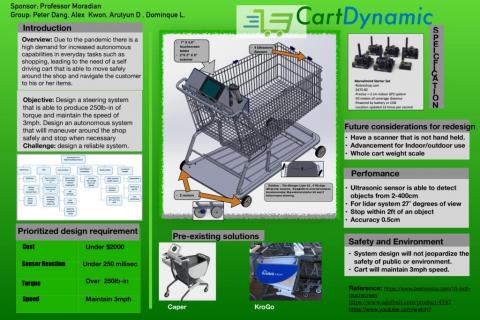CartDynamic
Background
CartDynamic is creating an easier and more efficient way to shop by modifying shopping carts to act autonomously. Firstly, an installed tablet will allow customers to enter their grocery list. After the tablet reads the list, a robotic map will be used to locate the items and plan an efficient route. Depending on the items, the route will prioritize different pathways. With the usage of a GPS and motors, the cart will be able to maneuver around the store with ease. The cart will also be incorporated with sensors and cameras that will allow the cart to stop for other carts and people. Once the cart reaches a designated location, the cart will stop and wait for the customer to scan and place the object into the cart. Once the customer finishes their grocery list, the cart will begin going towards the entrance. With the built-in tablet, the customer will be able to pay at the entrance and leave without having to stand in line.
Goals & Objective
- Must maintain speed despite the weight
- Must stop to avoid collision with customers and other carts
- Must follow the planned route
- Must create an efficient route that will prioritize frozen items last
- Must stop at located items and must wait for the customer to add to the cart
- Must return to the entrance once the grocery list is complete
- Must have a simple and customer-friendly UI
Simulation of Carts
Future Aspects
With our cart, we are able to minimize interactions between customers and employees in a store. However, there are some features that can be further optimized in order to ensure public safety. Handheld sensors provide more flexibility for scanning the bar and are cheaper to install into the cart, however, there are risks with Covid. For the sensors, instead of handheld sensors, there is potential for a sensor to be built into the cart that would allow customers to easily scan the item. This would remove a lot of the flexibility, but provide more safety in terms of Covid. Another feature that can be revamped in the future is the stop and go feature. Once the items are placed, the customer needs to press a button to start up the cart towards the next item. Instead of this system, there is potentially using weight sensors on the cart that detects when items are placed in the cart and starts after feeling the items.
Next, the versatility of the cart will be increased in the future. With older customers or customers who purchased a lot of goods, it would be harder to take the bags from the cart to their car. An installation of a GPS would help mobilization of the cart outdoors. In the future, the cart will be installed with a rechargeable battery in order to avoid a dead battery on a cart. Also, steering can be changed. Ackermann steering provides good steering, but castor steering provides a simpler system and more control.
Faculty and Sponsor
Professor Mark Walter
Email: m.walter@uci.edu
Professor David Copp
Email: dcopp@uci.edu
Sponsor Hossein Moradian
Email: hmoradia@uci.edu


